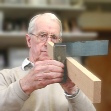

Stick sheets of various grades of aluminium oxide paper onto a flat surface such as a machine table or a sheet of float plate glass. Although expensive if bought for just this purpose, 3M's 'Spraymount' is ideal because it is made to be strippable.
Start with 80 grit. As you stroke the plane over the abrasive, you might be able to hear individual pieces of grit breaking loose from the paper, cutting deeper scratches in the surface as they roll between the plane and the abrasive. Make strokes parallel to the length of the plane and move slowly across the sheet so that these errant grits do not scratch diagonally across the sole. If they do, they will show up later, whereas deeper parallel scratches can hide among the others.
Use two hands over the frog, rather than on the handle and knob.
If the sole is convex in length, make it very slightly hollow by working with the plane at right-angles across a narrowish, say 60 mm (2-1/4 inches) wide, strip of abrasive. Take care not to remove too much before re-testing. Finish by longitudinal grinding.
Re-test with a rule or better still with a surface plate. As the accuracy improves, move gradually to finer grades of paper, but there's no need to strive for a mirror finish.
Contamination of finer grits by coarse grits is fatal to a good finish, so dust or vacuum clean the work surface and the inside of the plane at each change of grit .
This is the advice you may have seen before. It will certainly improve things, but it is unlikely to get the sole truly flat. If justified by the kind of work you do, if you are sufficiently fastidious and if you have the extra patience, you can improve on this seeScraping the Sole of A Plane.